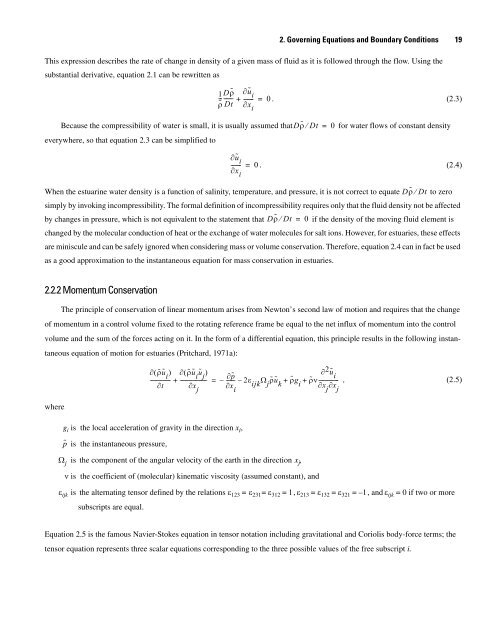A Semi-Implicit, Three-Dimensional Model for Estuarine ... - USGS
A Semi-Implicit, Three-Dimensional Model for Estuarine ... - USGS
A Semi-Implicit, Three-Dimensional Model for Estuarine ... - USGS
Create successful ePaper yourself
Turn your PDF publications into a flip-book with our unique Google optimized e-Paper software.
2. Governing Equations and Boundary Conditions 19<br />
This expression describes the rate of change in density of a given mass of fluid as it is followed through the flow. Using the<br />
substantial derivative, equation 2.1 can be rewritten as<br />
1<br />
ρ˜ -- Dρ˜ ∂ũ<br />
------i<br />
+ ------- = 0 . (2.3)<br />
Dt ∂x<br />
i<br />
Because the compressibility of water is small, it is usually assumed thatDρ˜ ⁄ Dt = 0 <strong>for</strong> water flows of constant density<br />
everywhere, so that equation 2.3 can be simplified to<br />
∂ũ<br />
i<br />
------- = 0 . (2.4)<br />
∂x<br />
i<br />
When the estuarine water density is a function of salinity, temperature, and pressure, it is not correct to equate Dρ˜ ⁄ Dt to zero<br />
simply by invoking incompressibility. The <strong>for</strong>mal definition of incompressibility requires only that the fluid density not be affected<br />
by changes in pressure, which is not equivalent to the statement that Dρ˜ ⁄ Dt = 0 if the density of the moving fluid element is<br />
changed by the molecular conduction of heat or the exchange of water molecules <strong>for</strong> salt ions. However, <strong>for</strong> estuaries, these effects<br />
are miniscule and can be safely ignored when considering mass or volume conservation. There<strong>for</strong>e, equation 2.4 can in fact be used<br />
as a good approximation to the instantaneous equation <strong>for</strong> mass conservation in estuaries.<br />
2.2.2 Momentum Conservation<br />
The principle of conservation of linear momentum arises from Newton’s second law of motion and requires that the change<br />
of momentum in a control volume fixed to the rotating reference frame be equal to the net influx of momentum into the control<br />
volume and the sum of the <strong>for</strong>ces acting on it. In the <strong>for</strong>m of a differential equation, this principle results in the following instantaneous<br />
equation of motion <strong>for</strong> estuaries (Pritchard, 1971a):<br />
where<br />
∂ρ˜ ( ũ<br />
i<br />
) ∂ρ˜ ( ũ<br />
--------------i<br />
ũ<br />
j<br />
)<br />
∂<br />
+ ---------------------<br />
∂p˜<br />
– ------- – 2ε<br />
∂t ∂x<br />
j<br />
∂x ijk<br />
Ω<br />
j<br />
ρ˜ ũ<br />
k<br />
ρ˜ g<br />
i<br />
ρ˜ ν<br />
i<br />
2ũ i<br />
= + + --------------- , (2.5)<br />
∂x<br />
j<br />
∂x<br />
j<br />
g i is the local acceleration of gravity in the direction x i ,<br />
p˜ is the instantaneous pressure,<br />
Ω j is the component of the angular velocity of the earth in the direction x j,<br />
ν is the coefficient of (molecular) kinematic viscosity (assumed constant), and<br />
εijk is the alternating tensor defined by the relations ε123 = ε231= ε312 = 1, ε213 = ε132 = ε321 = –1, and εijk = 0 if two or more<br />
subscripts are equal.<br />
Equation 2.5 is the famous Navier-Stokes equation in tensor notation including gravitational and Coriolis body-<strong>for</strong>ce terms; the<br />
tensor equation represents three scalar equations corresponding to the three possible values of the free subscript i.

















